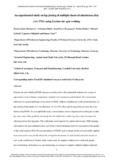JavaScript is disabled for your browser. Some features of this site may not work without it.
| dc.contributor.author | Zlatanovic, Danka Labus | |
| dc.contributor.author | Balos, Sebastian | |
| dc.contributor.author | Bergmann, Jean Pierre | |
| dc.contributor.author | Köhler, Tobias | |
| dc.contributor.author | Grätzel, Michael | |
| dc.contributor.author | Sidjanin, Leposava | |
| dc.contributor.author | Goel, Saurav | |
| dc.date.accessioned | 2020-05-07T14:21:22Z | |
| dc.date.available | 2020-05-07T14:21:22Z | |
| dc.date.issued | 2020-04-08 | |
| dc.identifier.citation | Zlatanovic DL, Balos S, Bergmann JP, et al. (2020) An experimental study on lap joining of multiple sheets of aluminium alloy (AA 5754) using friction stir spot welding. International Journal of Advanced Manufacturing Technology, Volume 107, April 2020, pp. 3093-3107 | en_UK |
| dc.identifier.issn | 0268-3768 | |
| dc.identifier.uri | https://doi.org/10.1007/s00170-020-05214-z | |
| dc.identifier.uri | https://dspace.lib.cranfield.ac.uk/handle/1826/15442 | |
| dc.description.abstract | Friction stir spot welding (FSSW) process is widely used in the automobile industry for a range of applications such as battery components, standard wire connectors and terminals. This manuscript addresses two grand challenges in the arena of FSSW, hitherto, unaddressed in the extant literature: (i) lap joining of thin sheets (0.3 mm thickness) of AA 5754 alloy and (ii) lap joining of more than two sheets using FSSW. To accomplish this task, a novel pinless convex shaped tool was designed to alter the stress state while gradually advancing the tool which led to achieving stress state necessary for obtaining defect free lap joints. The weld joints were inspected by optical microscopy, SEM imaging and analysed by nanoindentation tests and Vickers microindentation tests for assessment of the quality of the weld interface (WI). Process parameters of FSSW such as torque on the tool and axially applied load were used to analytically obtain the average local measure of peak normal and axial stresses as well as the coefficient of friction in the contact zone. In samples welded at low rotational speeds, strain-hardening mechanism was seen dominating in contrast to samples welded at higher rotational speeds, which showed thermal softening. As a direct consequence of this, the samples welded at low rotational speeds showed much higher hardness at the weld surface than the samples welded at higher speeds. A strong transition of strain hardening to thermal softening was noticeable beyond an applied strain rate of 400 s-1. | en_UK |
| dc.language.iso | en | en_UK |
| dc.publisher | Springer | en_UK |
| dc.rights | Attribution-NonCommercial 4.0 International | * |
| dc.rights.uri | http://creativecommons.org/licenses/by-nc/4.0/ | * |
| dc.subject | thermal softening | en_UK |
| dc.subject | strain hardening | en_UK |
| dc.subject | 5754 H-111 aluminium alloy | en_UK |
| dc.subject | thin sheet | en_UK |
| dc.subject | convex pinless tool | en_UK |
| dc.subject | friction stir spot welding | en_UK |
| dc.title | An experimental study on lap joining of multiple sheets of aluminium alloy (AA 5754) using friction stir spot welding | en_UK |
| dc.type | Article | en_UK |
Files in this item
The following license files are associated with this item:
This item appears in the following Collection(s)
-
Staff publications (SATM) [4367]

